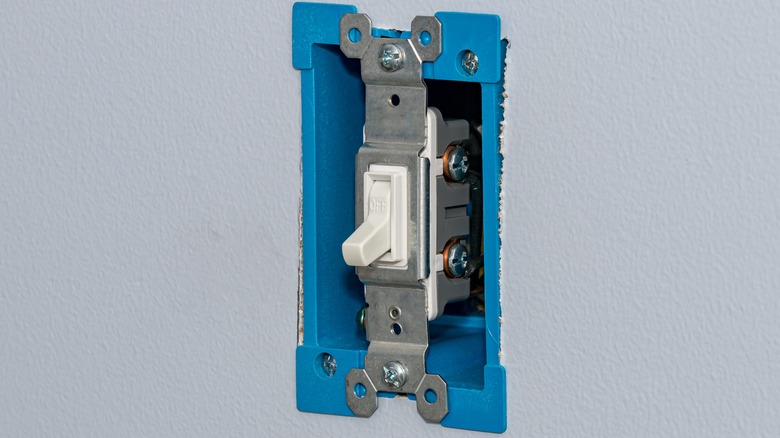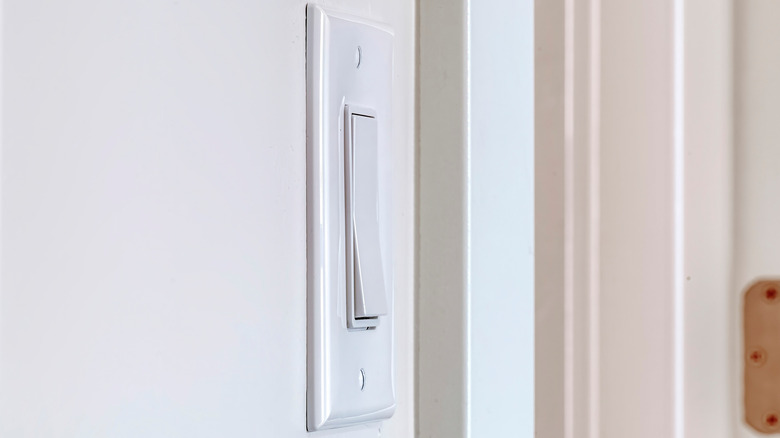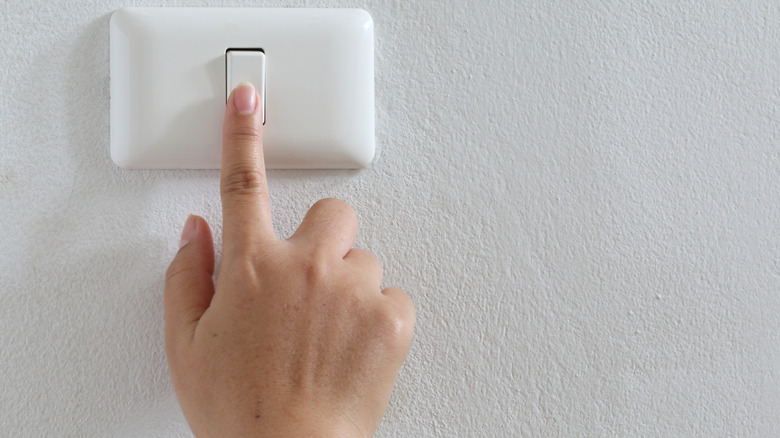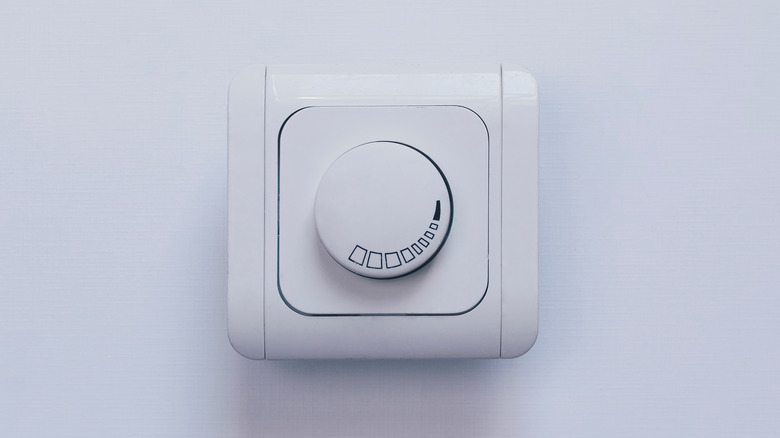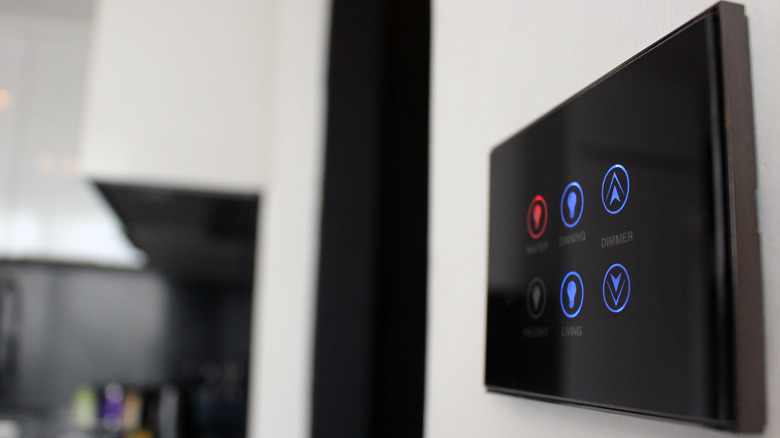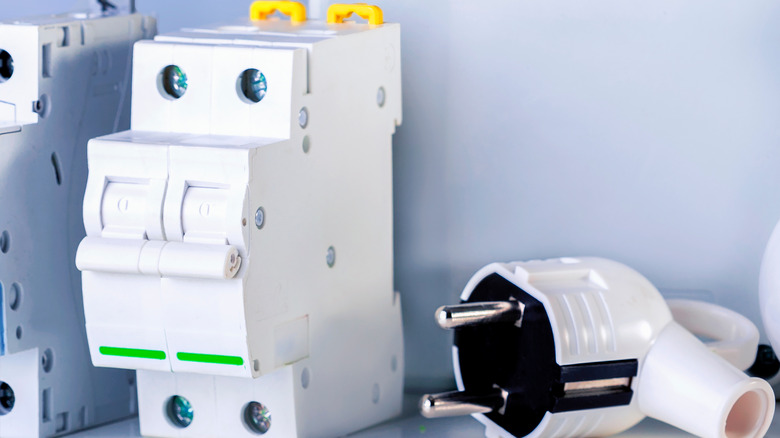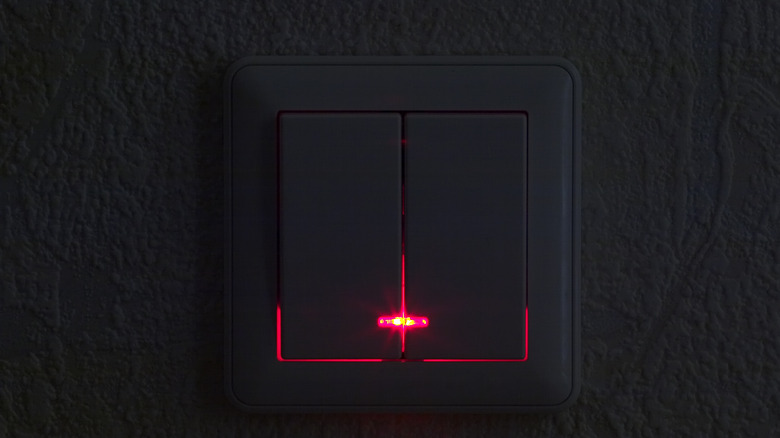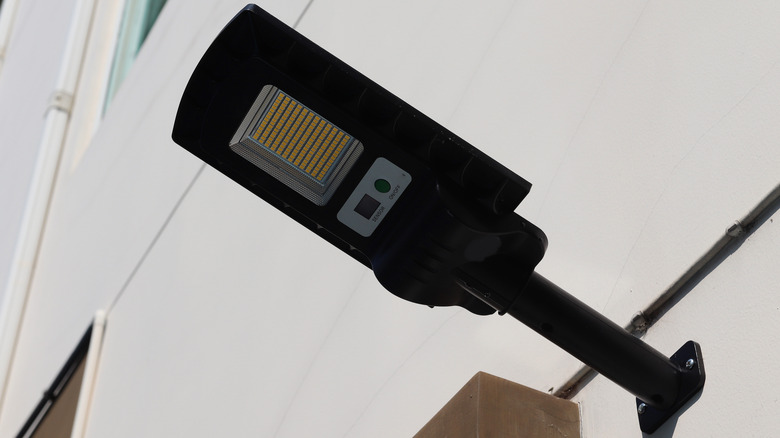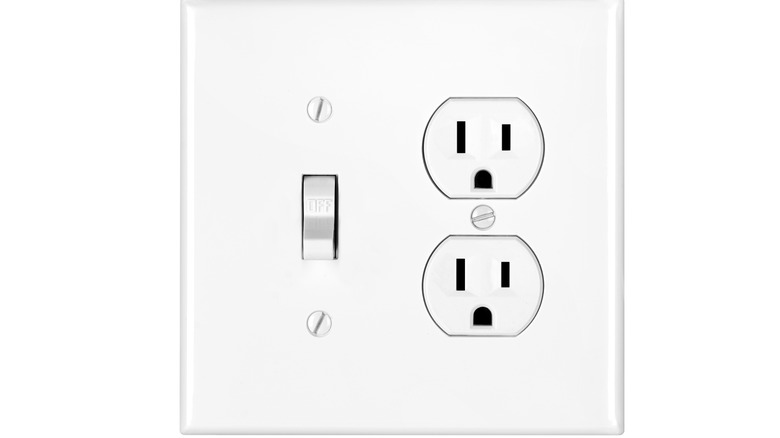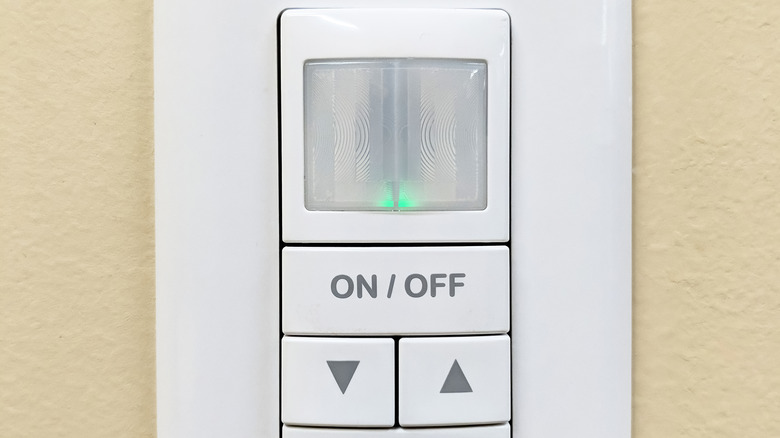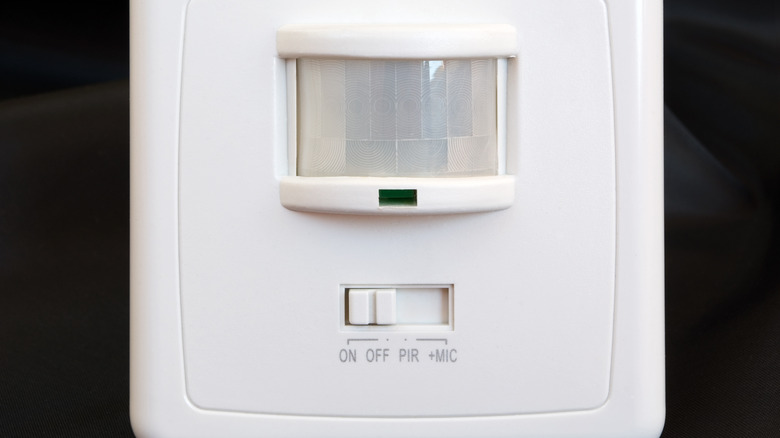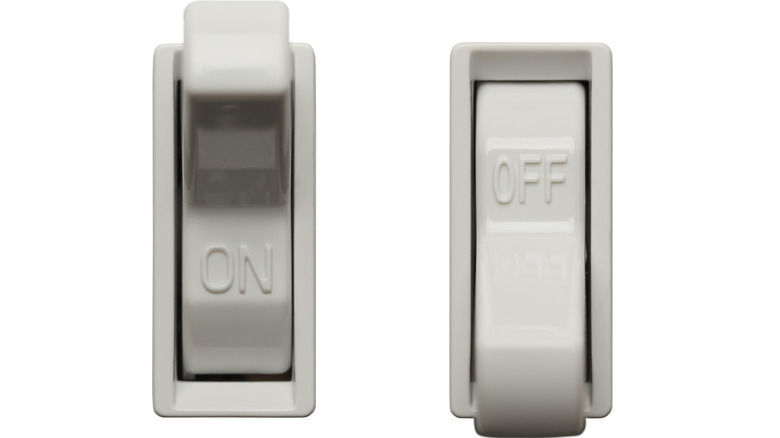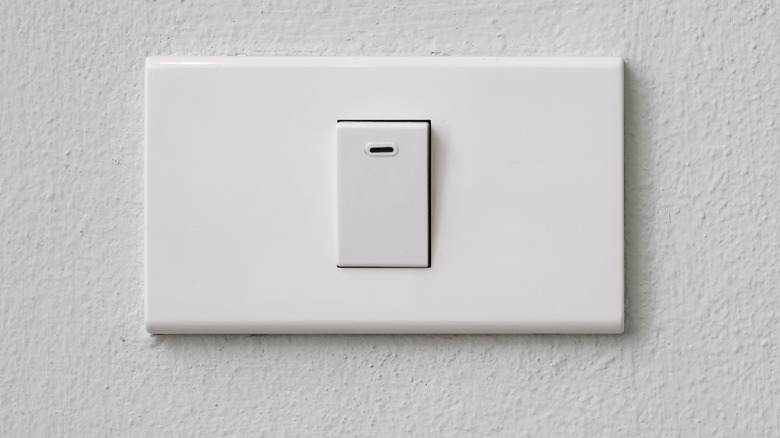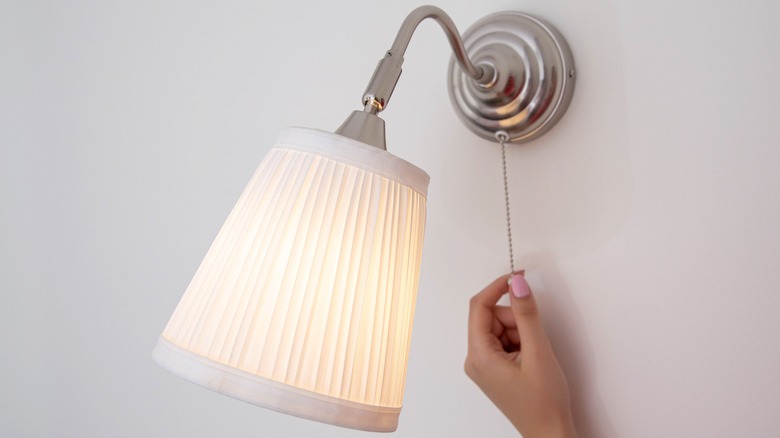15 Types Of Light Switches Found In Every Home
Illuminating your home involves more than just decorative light fixtures and the right level of brightness. You also need user-friendly light switches that are both purposeful and decorative in some cases. Each space has its own distinct necessities when it comes to light switches. Most likely, a simple switch that flips up to turn on the lights will suffice.
However, what if you want to be able to have the option of dimming? Or perhaps you'd prefer a switch that sort of "blends in" with the rest of the wall without being too conspicuous. Some spaces in your home might need a little extra safety feature, and there are also varieties that switch on the lights when an attached sensor detects movement. With so many choices, we've sorted out the information and bring you a guide to 15 types of light switches along with their traits and pros and cons.
Single-pole light switch
The single-pole is the most basic type of light switch. Its sole purpose involves activating the circuit when the switch is up and breaking the connection when it's flipped down. Plus, it only allows you to control the lighting from just one location, said Schneider Electric Blog.
You'll find two brass terminal screws that connect to the black and white wires. One of which connects directly to the source and the other to the fixture itself. Other types of single-pole switches also have an additional screw that's green. This part connects to the ground wire.
Rocker light switch
This type of light switch functions in a similar manner as the toggle switch but has a bit more aesthetic appeal, according to Electronics Hub. In fact, if you're looking for the type of light switch that blends in almost to the point of not being noticeable, the rocker might be your best choice. They're also ideal for kid's rooms because they require very little dexterity to operate, and they won't get caught on long sleeves.
Australian-style rocker switch
The Australian-style rocker switch is a smaller variety of the rocker. Judging by its name, you can probably guess that it's widely used in New Zealand and Australia. They're mostly installed for cabinet lighting and to control LED ceiling lights. One advantage to the Australian-style rocker is that it's fairly simple to install. However, you might opt for a different type if you're looking to illuminate a space that requires a large switch since this one is small compared to a toggle switch, as noted in Farm Food Family.
Dimmer light switch
Dimmer light switches allow you to easily adjust the brightness in rooms with a turn of the dial. If you have a hallway that requires some degree of dim lighting at night for more visibility, the dimmer gives you that option. This feature not only gives you the ability to create a certain kind of ambience, but it also saves on electrical power and your light bill. It also helps prolong the life of your bulb. Some varieties of dimmer switches are compatible with LED and CFL bulbs, giving you more energy-saving power, according to Home Depot.
Smart dimmer light switch
The smart dimmer can be controlled using your smartphone. In the case of the voice-activated variety, you would use a device like Amazon Echo or Google Home. Other types of smart dimmer switches require a remote control, and some can be paired with other smart gadgets and set up on a centralized hub. Some include a feature where you can set a timer which is useful if you're traveling. While the upfront cost is more expensive than traditional light switches, a smart dimmer light switch saves you money, as mentioned by Milton Electric Company.
Multi location dimmer switch
The multi-location dimmer gives you control over the brightness in several areas. They can be used in conjunction with another dimming switch, a smart-home or remote setup, or with a 3-way switch. Additionally, they come equipped with a switch to turn the lights on and off, along with buttons for controlling the brightness. Plus, they work well with LED bulbs, incandescent, fluorescent, multiple-load, and low-voltage bulbs, per 1000 Bulbs. The only catch to using this type of light switch is you have to make sure you follow the instructions closely if you're setting a timer.
Double-pole light switch
Going back to the single location type of light switch, the double-pole is distinguished by its four terminals, specifically two dark and two brass and the "on" and "off" engravings on either side. Plus, it also contains a ground terminal. While it's often used in industrial settings, being that it's rated for 30 amps, you'll find the double-pole light switch in some homes. However, its main purpose is for turning on large appliances and machinery, as noted in The Spruce.
Illuminated light switch
The illuminated light switch makes a great alternative to the dimmer switch if you need to be able to see your switch at night but don't necessarily want any extra illumination in the space. Hence, some of the best areas for this type of light switch include restrooms, stairways, hallways, entryways, and basements, according to Leviton. You can find them in a single-pole toggle in choices of three-way or four-way. Although you can utilize CFL bulbs for the illumination on the switch, many come equipped with LEDs.
Motion-activated light switch
Motion-activated light switches are perfect for those who want their lights to be turned on the moment someone arrives a few feet away from the property. Usually used in porches and other outdoor areas around the home, these lights work off the basis of passive infrared sensors, detecting motion from anything that gives off infrared radiation, which causes the light to shine. Therefore, they offer an extra layer of home security, as described in Electronics Hub. Plus, they help save electrical energy when the light is not needed.
Pole receptacle combo switch
The pole receptacle combo switch serves well for saving space and maximizing efficiency in rooms where numerous gadgets or appliances might be used, as described in Worst Room. Equipped for duo purposes, this type of light switch is the perfect option where you might have a work light located under a shelf or cabinet where you might need to plug in an appliance, like your can opener. They also work well in bathrooms where you have little wall space but still need both a light switch and an outlet, thus making it a truly convenient choice.
Proximity light switch
When it comes to usage, the proximity light switch might be one of the easiest switch options to employ. You just simply enter the room, and the light switches on. If you or your family members sometimes forget to flip the switch off, this type of switch eliminates that issue, thus providing one of the most eco-friendly options. The only drawback, according to Home Esthetics, is that the light may turn on in the middle of the night, even when a pet enters the room. Prevent getting started in the night by installing them in living spaces.
Sound-activated light switch
When you envision a sound-activated light switch, you might see the "Clap On Clap Off" commercials from the 80s -– if you're old enough. However, the difference between those models (that are still being sold today and are plugged into outlets) and other varieties is some have the voice activation feature, which is connected to another smart device like Amazon's Alexa or to your smartphone using Siri, as mentioned by Smart Homerig. With this kind of convenience, you can use them in just about every space in your home.
Toggle light switch
When it comes to switches that are the most commonly used in residences, that would be the toggle ones. Being very easy to operate, all you need to do is just flip them up or down. As described in Everyday Home Repairs, their accessibility comes from the fact that they are inexpensive and reliable. Plus, they last for many years. The best part about them is the ON/OFF text on them, so even a child can operate them without any hassle. It allows for a simple two-way operation.
Touch-plate switch
A touch-plate light switch presents a more sophisticated wall-mounted option that's also commonly used in the modern home. While similar to the toggle switches, they don't need an up or down flip. Instead, the activation occurs immediately after the plate is touched, per Home Depot. Since they can be touch-sensitive, these types of light switches can differentiate between a finger touch from other types of touch. As a mere touch is all that is needed, they are not only easy to operate but quiet as well.
Pull-chain/pull-cord switch
This type of light switch might be considered old school, but it's still a common feature on a variety of fixtures. Old houses that want to keep that vintage or retro look tend to use the pull cord switch, as noted in Farm Food Family. The most common usage nowadays is in garages, shops, and basements where overhead lights are commonly found. However, you still find these switches on ceiling fans that have lights on their base and larger light fixtures.

